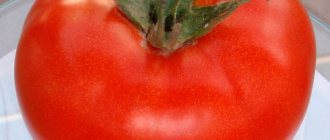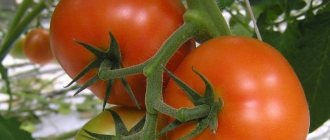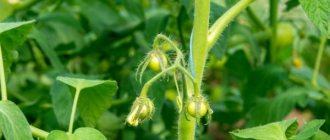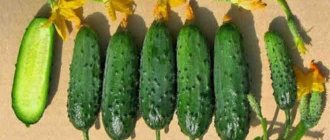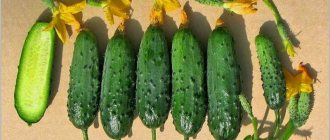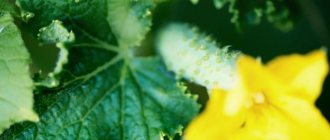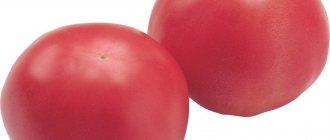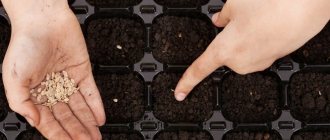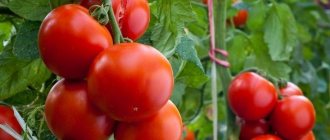Tomato Bagheera f1: variety description
| Variety name | Bagheera |
| general description | Early maturing, determinate hybrid of tomatoes with high yield |
| Originator | Russia |
| Ripening period | 65 days |
| Form | The fruits are round, slightly ribbed towards the stalk. |
| Color | Red |
| Average weight of tomatoes | 80-250 grams |
| Application | Universal |
| Productivity of the variety | up to 10 kg per square meter |
| Features of cultivation | Standard agricultural technology |
| Disease resistance | Resistant to major diseases, but requires prevention |
Tomato Bagheera F1 is an early-ripening, high-yielding hybrid of the first generation.
The bush is determinate, compact, with moderate formation of green mass. You can get acquainted with indeterminate varieties here. The leaves are simple, medium-sized, dark green. Tomatoes ripen in clusters of 4-6 pieces. Productivity is high, from 1 sq. m of plantings, you can collect up to 10 kg of selected tomatoes .
You can see the yield of other varieties in the table:
| Variety name | Productivity |
| Bagheera | up to 10 kg per square meter |
| Olya-la | 20-22 kg per square meter |
| Nastenka | 10-12 kg per square meter |
| King of Kings | 5 kg per bush |
| Banana red | 3 kg per bush |
| Gulliver | 7 kg per bush |
| Brown sugar | 6-7 kg per square meter |
| Lady Shady | 7.5 kg per square meter |
| Rocket | 6.5 kg per square meter |
| Pink Lady | 25 kg per square meter |
The fruits are medium-sized, weighing from 80 to 250 g. On the lower branches, the tomatoes are larger. The tomatoes are smooth, flat-rounded, with pronounced ribbing at the stalk. The color of ripe fruits is deep red, uniform, without spots or stripes. The pulp is moderately juicy, dense, fleshy. There are at least 6 seed chambers. The sugar content is 2.1%, dry matter in the juice is 5%. The taste of ripe Bagheera tomatoes is pleasant, sweetish, not watery.
The table below provides comparison data on fruit weight for other tomato varieties:
| Variety name | Fruit weight |
| Bagheera | 80-250 grams |
| Fat Jack | 240-320 grams |
| Premier | 120-180 grams |
| Broody | 90-150 grams |
| Polbig | 100-130 grams |
| Brawler | 100-180 grams |
| Black bunch | 50-70 grams |
| Grapefruit | 600-1000 grams |
| Kostroma | 85-145 grams |
| American ribbed | 300-600 grams |
| The president | 250-300 grams |
Advantages and disadvantages of the variety
The Bagheera F1 hybrid has a lot of positive properties. Thanks to them, the tomato has become widely known and popular both among amateur gardeners and among professionals.
Bagheera F1 tomatoes can grow to significant sizes
pros
- High yield.
- Good presentation of the fruit.
- Ease of use, low bush height.
- Plants are insensitive to temperature fluctuations.
- Excellent immunity to many common tomato diseases.
- Good keeping quality and transportability of fruits.
- Resistance to cracking.
- Tomatoes picked green ripen quickly during storage.
- The versatility of the crop.
- Good tasting qualities of the fruit.
Minuses
- Tomato seeds can only be purchased; you cannot breed them yourself.
- Original planting material is quite expensive.
- In most regions, Bagheera F1 tomato can only be grown in protected soil conditions.
- The plant needs to be tied to a support.
- They need disease prevention, regular watering and fertilizing.
Origin and application
The Bagheera variety was bred by Russian breeders and zoned for areas with a temperate climate. It is recommended to grow in open beds and under film; in regions with cold climates, planting in a greenhouse is possible.
Thanks to the thick walls and thin but dense skin, the collected tomatoes are well stored and can be transported for a long time. Bagheera tomatoes, picked at the technical ripeness stage, ripen successfully at room temperature.
The fruits are universally used; they can be eaten fresh and used for making salads, soups, sauces, purees, and juices. Tomatoes are suitable for whole-fruit canning.
Soil fertilization
Fertilizing of Bagira variety tomatoes is carried out in several stages.
The first time fertilizer is applied two weeks after planting the seedlings on the site. Suitable composition of the mineral mixture per square meter of area: 8 g of nitrate/urea, 20 g of superphosphate and potassium salt.
Important! It must be taken into account that excess nitrogen leads to rapid and abundant growth of greenery, to the detriment of the ovary.
After three weeks, phosphorus and potassium fertilizers are added again. During the growth of the bush, the formation of flowers and the formation of ovaries, you can use a special ready-made fertilizer “Sudarushka-tomato”. This composition prevents the occurrence of fungal diseases and increases productivity. Dissolve a teaspoon of the mixture in 10 liters of water and pour half a liter of the solution under each bush.
Complete feeding of the Bagheera F1 variety is also important during fruit ripening. To increase productivity and the appearance of new ovaries, use nitroammophoska (2 tablespoons of fertilizer are dissolved in a bucket of water).
Features of cultivation
Bagheera variety tomatoes are more convenient to grow in seedlings. The seeds do not require special treatment; they undergo all necessary procedures before sale. But you can use growth stimulants. For seedlings, a light substrate is prepared - a mixture of garden soil with humus or peat. The seeds are sown in a container with a depth of 1.5-2 cm. The plantings are sprayed with water and placed in a warm place until seedlings emerge.
Young plants are exposed to bright light. When the first pair of true leaves appears, the seedlings are planted and then fed with liquid complex fertilizer. Before planting in the ground, tomatoes are hardened off by placing them in fresh air, first for several hours, and then for the whole day.
Transplanting to the beds begins in late May or early June. In the first days, young plants can be covered with film. The distance between the bushes is 40-50 cm, no support is required. Tomatoes need to be watered abundantly, but infrequently, with warm, settled water. Every 2 weeks the bushes are fed with a complete complex fertilizer.
It is very important to choose the right soil, both for planting seedlings and for adult plants in the greenhouse. An article about types of soil for tomatoes will help you figure this out. You will also find on our website information on how to prepare the soil for tomatoes yourself.
Read more about how to fertilize tomatoes correctly and with what:
- Organic, mineral, phosphorus, complex, ready-made fertilizers.
- TOP best.
- Yeast, iodine, hydrogen peroxide, ammonia, ash, boric acid.
- Fertilizers for seedlings, foliar and when picking.
Reviews from those who grew tomatoes
Vasilisa : My family really loves tomatoes, and that’s why we grow many different varieties. Including, we plant “Bagheera”. She is not whimsical. When their season ends, the picked, unripe fruits ripen on their own. I mulch the soil with straw and humus. From 1 sq. m gained 8.5 kg. The seedlings love light very much, I tried to keep them more in bright places. Suitable for any dish. It doesn't disappoint, I will buy again.
Peter : The weather in our area was not encouraging, but despite this, Bagheera pleased us with a good harvest. The tomatoes are beautiful and tasty; they look good in a jar for winter preservation. They stayed fresh for 20 days and did not spoil. Although the summer was very rainy, to prevent the bushes from picking up rot, I treated the stems with 1% Bordeaux mixture. I plant them in places where they are ventilated. And they never got sick or were attacked by insects.
Diseases and pests
The Bagheera tomato variety is resistant to fusarium, verticillium, alternaria and other typical diseases of nightshades in greenhouses. However, it is impossible to do without preventive measures. Before planting, it is recommended to disinfect the soil with a hot solution of potassium permanganate. Other methods of combating diseases can be used.
Young plants are regularly sprayed with phytosporin or another non-toxic drug with an antifungal effect to prevent late blight.
Features of planting and care
The period from germination of tomato seeds to the appearance of the first ripe Bagheera tomatoes is approximately 86-99 days.
Advice! It is better to grow Bagheera F1 tomatoes using the seedling method. Moreover, no special treatment is required for the seeds.
Growing seedlings
Since the seed producer carries out preparatory procedures independently (disinfection, hardening, culling), the seeds of Bagheera tomatoes can be planted immediately.
A mixture of garden soil, humus and peat is used as fertile soil. If some components are missing or small, then you can buy ready-made soil for tomato seedlings in specialized stores.
- The soil is poured into a container, moistened and depressions (1-2 cm) are formed on the surface in the form of even rows.
- Tomato seeds Bagheera F1 are laid out in depressions, covered with soil and the soil is slightly moistened.
- The box is tightly closed with a piece of polyethylene and placed in a warm room for the germination of Bagheera tomato seeds.
- As soon as the grains germinate, the container is placed in a bright place. When the tomato seedlings grow two leaves, the seedlings can be placed in separate containers (cups).
During the period of growth of seedlings of the Bagheera variety, the seedlings are fed and periodically taken out into the fresh air for hardening. By the time they are transplanted into open ground, they should already be outdoors all day.
To plant Bagheera F1 sprouts on a summer cottage, you need to choose a period when the threat of night frosts has already passed and the earth has warmed up sufficiently. The optimal period is the end of May or the beginning of June.
It is better to plant tomatoes in the afternoon or choose cloudy weather. In such conditions, the sprouts will take root more comfortably and will not wither.
Advice! When planting Bagheera tomatoes, the distance between the bushes should be at least 40 cm, and between the rows approximately 85-95 cm.
Before planting seedlings, it is advisable to add compost, a little ash and urea to each prepared hole. It is recommended to use half a liter of wood ash per square meter, a bucket of compost/humus and urea - 1 tsp. The soil in the cups should be slightly moistened. This will help you carefully remove the sprouts without damaging the root system.
The optimal depth of the hole is the height of the cup. If tomato seedlings of the Bagheera variety were purchased without cups, then when planting the sprouts, you need to make sure that the first leaf is not buried, but remains above the soil.
Useful video
In the table below you will find links to tomato varieties with different ripening periods:
| Early ripening | Mid-late | Mid-early |
| Pink fleshy | Yellow banana | Pink King F1 |
| Ob domes | Titanium | Babushkin |
| King of the Early | Slot F1 | Cardinal |
| Red Dome | gold fish | Siberian miracle |
| Soyuz 8 | Raspberry miracle | Bear Paw |
| Red icicle | De Barao red | Bells of Russia |
| Honey cream | De Barao black | Lev Tolstoy |
If you find an error, please select a piece of text and press Ctrl+Enter.
Bush care
Basic care measures:
- Watering is not frequent, but plentiful. Under no circumstances should you water with cold water, use only warm, settled water. The best option is to install a drip irrigation system;
- Equally important is loosening. After transplanting to a permanent place, the soil is loosened after 4-5 days. In the future, they loosen after each watering, to a depth of about 10 cm, since deeper loosening can cause injury to the root system;
- Once every 14 days, the bushes are fed using a complete complex fertilizer. The first feeding is carried out 2-3 weeks after transplantation, with mineral mixtures. After 3-4 weeks, use fertilizers enriched with potassium and phosphorus. At the moment of ovary formation, fertilizing is applied to prevent the occurrence of fungal diseases. To increase the number of ovaries formed, it is permissible to use nitroammophoska;
- The soil must be mulched;
- Despite their determinacy, it is still better to tie up the bushes. Thanks to this, the fruits will not fall on the ground, which will avoid the occurrence of diseases or damage by insect pests;
- The formation of a tomato bush is carried out in 3-4 stems.
Advantages and disadvantages
The description of the Bagheera tomato, a fairly successful breeding crop, contains many positive characteristics:
See also
Characteristics and description of the tomato variety Shapka Monomakh, its yield Read
- The culture is resistant to various diseases and has strong immunity. Tomatoes are not afraid of parasites either. The tomato produces an excellent harvest even in regions with a cool climate.
- Compared to other varieties, the crop begins to bear fruit quite early. Already on the 65th day you can get ready-made ripe natural products. Fast ripening is one of the main advantages of the Bagheera variety.
- One adult bush can produce more than 100 fruits per season.
- The fruits are not afraid of transportation. They can be transported over long distances. Tomatoes are not afraid of heat treatment and do not burst at hot temperatures.
- Tomatoes are characterized by wonderful taste.
- The fruits can easily ripen at home.
The variety has few disadvantages, the main one being that the seeds of the hybrid cannot be prepared independently for planting the next season.
Advantages of the variety
The main advantage of Bagheera tomatoes, of course, is the early ripening of the fruit - 65 days after planting the seeds. This variety is resistant to drought, cold and pests, as well as various diseases. High yield - up to one hundred fruits from one bush - is also an undeniable advantage of these hybrid tomatoes. The only, but not the most unpleasant, drawback is that it is impossible to independently prepare seeds for planting. But along with numerous advantages, this minus will not seem significant to you when choosing tomato varieties.
